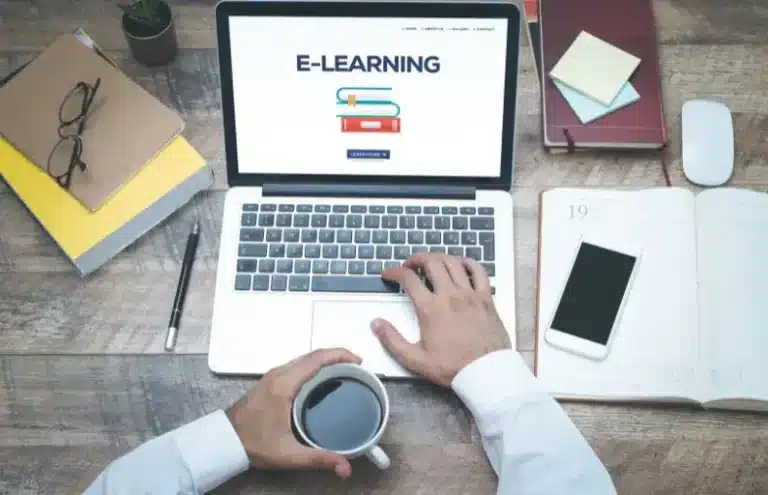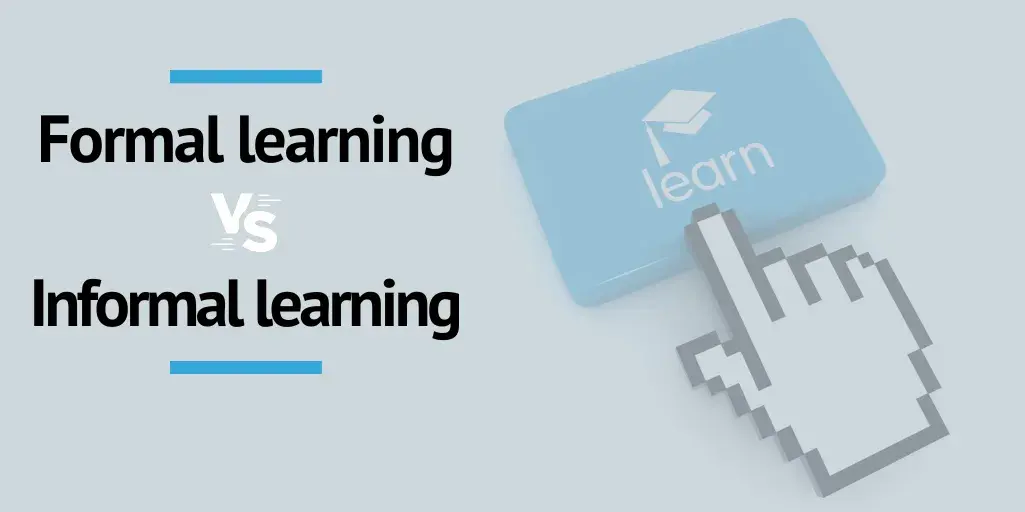For decades, formal learning has been almost exclusively linked to classrooms, diplomas and structured programmes. Knowledge was something that was transmitted from an expert figure to the learner, following a defined and validated sequence. In this framework, formal learning was consolidated as a guarantee of competence and academic or occupational progress was based on following this established path.
But what if this model was no longer sufficient?
In the current context, marked by the speed of change, constant access to information and digital transformation in education, learning has ceased to be a specific moment and has become a continuous practice.
Every conversation, every problem we solve with a colleague or every resource we search for online is part of what we now understand as informal learning.
The most innovative organisations are beginning to value this type of experience as an essential part of their training strategies, recognising that the transformation of learning is no longer just about structured content, but about creating environments that favour interaction, autonomy and practical development.
Does it still make sense to talk about formal and informal learning as two separate worlds? What role does non-formal learning play in this equation? And how should companies and training centres adapt to this changing scenario without losing rigour and effectiveness?
The answer is not binary. The future of vocational training requires combining the best of both approaches, understanding their limits, their strengths and, above all, the new formal, non-formal and informal teaching contexts that are emerging strongly in the era of digital transformation in education.
In this article, we will look at formal vs. informal learning, how to define collaborative learning, and know the formal learning definition, informal learning definition and non-formal learning definition, understand the digital transformation in education, and explain the formal learning examples, non-formal and examples of informal learning.
Formal learning vs. informal learning: definition, differences and contexts

Is it possible to learn without a classroom, without a teacher, without an exam at the end?
This question, which a few decades ago would have sounded provocative, is today almost obligatory in any conversation about vocational training.
Mass access to information, new digital tools and changes in the way we work have profoundly modified our ways of acquiring knowledge.
That is why, before analysing where training is going, it is essential to understand what formal and informal learning is, as well as the formal, non-formal and informal teaching contexts in which each one takes place.
What we mean by formal learning
What is informal learning and how does it manifest itself in practice?
Unlike informal learning, informal learning does not follow a pre-established script or require a formal structure for it to occur. It is spontaneous, often invisible, but deeply valuable.
It takes place in conversations with peers, in autonomous information seeking, in solving a new problem, or simply in watching someone else perform a task. It is, in essence, the learning that occurs as we work, collaborate or actively explore.
This type of learning is closely linked to the digital transformation in higher education and in the corporate environment, as digital tools have multiplied the opportunities to access knowledge in real time.
In a world where urgency does not always wait for structured training, the ability to learn on the go becomes a strategic competence.
Moreover, this approach connects with current trends such as microlearning, networked learning or the use of the latest trends in generative AI in education, where the informal is becoming increasingly sophisticated and effective.
Non-formal learning: somewhere in between
In between these two extremes is non-formal learning, a category that often goes unnoticed but is key in professional environments.
This is training that, without being regulated by an official education system, is intentional, structured and organised. Examples are in-company workshops, continuing education courses, bootcamps, coaching sessions or communities of practice.
Although they do not always lead to a formal qualification, these experiences have concrete objectives, defined structures and, in many cases, a high degree of direct applicability.
They are a key part of meeting the challenges of digital transformation in training, as they allow for rapid adaptation to changing needs, while maintaining a certain methodological order.
This type of learning can be managed in an agile way, allowing training managers to design specific content for their teams, without depending on external regulatory frameworks.
In this sense, initiatives such as eLearning training as a key to the digital transformation of companies demonstrate how non-formal learning can become a powerful tool for the development of internal talent.
Key differences
| Formal learning | Informal learning | |
|---|---|---|
| Structure | ||
| Structure | Structured, planned, with defined curriculum.. | Unstructured, spontaneous, without curriculum. |
| Intentional | ||
| Intentional | Intentional, with set pedagogical objectives. | Not always intentional; arises in everyday practice or interaction. |
| Context | ||
| Context | Educational institutions, official programmes, companies with regulated training | Workplace, social networks, conversations, daily practice. |
| Certification | ||
| Certification | Yes, a recognised certification is awarded on completion. | No, generally no certification. |
| Evaluation | ||
| Evaluation | Systematic and planned evaluation. | Non-systematic; based on observation, feedback or results. |
| Trainer's role | ||
| Trainer's role | Clear teaching figure, with role of guide and evaluator. | No formal figure; can be peer or self-learning. |
| Examples | ||
| Examples | School, university, certified courses, subsidised training. | Informal mentoring, observation, problem solving, online searches. |
| Type of learning | ||
| Type of learning | Theoretical-practical, with a solid conceptual basis. | Practical, based on direct experience. |
| Flexibility | ||
| Flexibility | Less adaptability to individual pace. | High adaptability; occurs according to the needs of the moment. |
| Recognition | ||
| Recognition | Institutionally and occupationally recognised. | Little formal recognition, although valued in practice. |
| Temporariness | ||
| Temporariness | Defined duration, often medium to long term. | Continuous, no fixed duration. |
Formal, non-formal and informal learning contexts: an evolving ecosystem
Instead of seeing these types of learning as watertight compartments isolated from each other, more and more experts agree that they function as an interconnected system.
Formal, non-formal and informal learning contexts coexist in the professional life of any employee: a person can attend a certified course (formal), participate in a practical workshop (non-formal) and at the same time learn autonomously by solving a challenge on the job (informal).
Transforming learning is about recognising this co-existence and designing strategies that make the best of each. Training leaders who understand how these contexts intertwine will be able to design learning paths that are more effective, motivating and aligned with business objectives.
From Formal Learning to Constant Interaction: The Paradigm Shift

For a long time, learning meant attending a course, listening to an expert and passing an exam.
That linear sequence suited a more predictable world of work, where the skills needed changed slowly and degrees served as sufficient credentials for an entire career.
But is that logic still valid in an environment where what we learned five years ago can become obsolete in a matter of months?
Today’s business reality demands a transformation of learning that is not limited to digitising content or migrating courses to the online environment. It goes much further: it involves moving from a one-way transmission model to an approach based on continuous interaction between people, resources and contexts.
Formal learning, with all its structure and rigour, has been crossed by new dynamics that demand flexibility, dialogue and constant updating.
Digitalisation as an accelerator of change
One of the main drivers of this new paradigm has been the digital transformation in education and corporate training. It is no longer just a matter of accessing a course from a computer, but of incorporating tools that allow interaction, collaboration, personalisation of pace and enriching the learning experience with multiple formats.
New generation LMSs not only host content but, even more importantly, provide spaces for communication between learners and tutors, forums for collective discussion, teamwork functionalities and tracking systems that allow trainers to actively intervene during the process.
Instead of simply evaluating results, training managers can accompany, dynamise and drive learning in real time.
This new ecosystem has blurred the boundaries between formal and informal: a course can include a structured video lecture and, at the same time, encourage informal learning through challenges, peer-to-peer feedback or collaborative projects.
Thus, beyond modernising the tools we use, the digital transformation of training is redefining pedagogical processes.
The culture of lifelong learning: beyond the occasional
Another key change is the evolution of the concept of training as a one-off event towards a logic of continuous learning culture.
Companies can no longer afford to rely exclusively on annual training programmes or sporadic refresher campaigns. What they need is to generate a continuous learning culture, in which each professional has the possibility , in which each professional has the possibility – and the responsibility – to update himself or herself on a permanent basis.
This change of mentality implies moving from control to accompaniment, from closed itineraries to personalised routes, and from content as an end to knowledge as a means. In this new culture, leaders encourage spaces where their teams can learn autonomously, collaboratively and in a way that is connected to the real challenges of the business.
Formal and informal learning coexist in this logic. On the one hand, there is still a need for structured foundations and solid conceptual frameworks. On the other hand, these foundations are complemented by discovery, curiosity and the daily exchange of ideas that only happens in practice, in human interaction and in professional practice.
In short, what is changing is not only the technology but the way in which we understand the act of learning: less focused on the accumulation of knowledge and more oriented towards the shared construction of knowledge, towards action, towards the real transformation of competences into results.
Spaces where informal learning is strongest
There is learning that does not appear in textbooks, that is not assessed with exams or measured with certificates.
Learning is also about asking a colleague, solving an unexpected challenge, improvising a solution and, from there, improving.
In the business world, such everyday experiences are no longer considered anecdotal, but are becoming a central part of the training strategy. Informal learning, far from being an add-on, is establishing itself as one of the most effective sources of professional development.
This shift responds, to a large extent, to the current needs of the world of work: urgency, adaptability, collaborative working and agile problem solving.
In many sectors, waiting for a formal course to open to acquire a key competency is simply not feasible. That is why the organisations that are leading the learning transformation are those that enable environments where informal learning is easy, natural and recurrent.
Learning just when you need it: access to information in real time
Imagine an employee needs to understand a new procedure to resolve a customer issue. He doesn’t have time to enrol in a course or wait for someone to train him.
What does he do? Search the company database, ask a colleague or review an internal tutorial.
This type of reaction, which is becoming increasingly common, is a reflection of unstructured but extremely effective learning: informal learning based on immediacy and access to information at the right time.
Thanks to the digital transformation in training, it is now possible to organise internal knowledge so that it is available when it is really needed.
E-learning platforms make it possible to integrate dynamic resources, collaborative wikis, collaborative classroom and materials accessible from any device. In this way, content ceases to be a static block and becomes a living tool at the service of action.
The value of collaborative learning and peer mentoring
Another space where informal learning is enhanced is in the collaborative learning. But how do we define collaborative learning?
Far from the classroom, knowledge circulates constantly in conversations, team dynamics and internal mentoring processes. It is no coincidence that many companies are promoting communities of practice, buddying programmes or reverse mentoring initiatives: they are all based on the idea that learning together is more effective than learning in isolation.
In this type of context, the role of the expert is diluted and all the members of the team can become references in a specific area. This horizontality favours the transfer of knowledge, strengthens the links between colleagues and reinforces the idea that professional development is not something that is imposed from outside but is built from within.
Moreover, this approach has a fundamental advantage: it allows for the integration of non-formal and informal learning within the organisational culture. It is not necessary to institutionalise every training process, but it is necessary to facilitate spaces where knowledge is shared, documented and recognised.
Constant feedback: improvement as a driver for learning
In agile and results-oriented environments, real-time feedback becomes a driver of continuous learning. Every meeting, every handover, every constructive feedback offers an opportunity to grow, correct and refine skills.
This kind of dynamic is at the core of many of today’s work methodologies, from design thinking to Scrum team retrospectives.
The key is to create cultures where making mistakes is accepted as part of the process, as long as it is accompanied by a review that allows learning from the mistake.
In this sense, formal and informal learning can be articulated in a complementary way: while formal content provides the theoretical basis, informal mechanisms help to integrate this knowledge into practice, adjusting it to the nuances of day-to-day life.
Thus, the digital transformation in education not only digitises resources but also facilitates immediate improvement circuits. Continuous assessment tools, instant surveys, training chats or collaborative environments make it possible for learning to occur in the natural flow of work, without the need to stop or wait.
Areas where formal learning remains essential

Amidst the enthusiasm for new ways of learning and the flexibility offered by informal learning, it is worth pausing. For not everything can or should be learned in spontaneous or unstructured environments.
There are contexts where security, professional ethics, technical precision or human development require a solid, structured and validated basis.
In other words, there are areas where formal learning is not one option among many, but an irreplaceable necessity.
Recognising the value of formal learning does not imply disregarding other forms of development, but understanding that each learning context has its own requirements.
This is one of the keys to effectively managing formal, non-formal and informal learning contexts: knowing which one best meets each need, without falling into generic solutions or fads.
Early childhood education and special education: beyond content
In the early stages of development, learning goes far beyond transmitting knowledge. In childhood, learning takes place by observing, imitating, interacting, bonding and feeling safe.
This is where formal learning plays a fundamental role: not only because of the structured content that is taught, but also because of the figure of the educator as an emotional reference, guide and mediator.
In the case of special education, this human accompaniment becomes even more relevant. Technology can offer support, accessibility and valuable resources, but it does not replace the empathetic and adaptive capacity of a trained professional.
Digital transformation in education must serve these needs, not override them.
School and university education: structured frameworks to shape thinking
During school and early university years, learning requires acquiring information but also developing thinking structures, critical skills and communicative competences.
This process requires time, guidance, formative assessment and, above all, meaningful interaction with others: teachers, peers, tutors.
Informal learning can and does complement these stages through extracurricular initiatives, collaborative work or digital resources. However, delegating the entire learning process to individual initiative or automated platforms would be insufficient and, in many cases, counterproductive.
The digital transformation in higher education, therefore, should not seek to replace the teacher but rather to reinforce his or her capacity to accompany, personalise and enrich the student experience.
Professional careers with high technical and practical demands
Some professions require a level of accuracy and responsibility that makes rigorous, supervised training essential. No one would want to operate with a surgeon who has learned by trial and error or cross a bridge designed by someone who has only watched video tutorials.
In these cases, formal learning is the only way to ensure both the acquisition of technical skills and the validation of their correct application.
Fields such as medicine, architecture or engineering require extensive training paths, tutored practice, controlled simulations and strict evaluation. This is where the combination of technology and pedagogy becomes particularly valuable: the digital transformation in education can provide immersive learning, simulators, augmented reality or virtual training systems, but always under the supervision and guidance of expert trainers.
Technical crafts and practice-based training: learning-by-doing with guidance
There are skills that cannot be acquired by reading manuals or watching from the sidelines. Car mechanics, professional gastronomy, carpentry or building trades require practical training, direct observation and on-site correction. You learn by doing, but not just any old way.
In these environments, non-formal learning and informal learning can play an important role – for example, through mentoring or peer learning – but only if they are based on a structured foundation that ensures quality, safety and progressive improvement.
Here again, the challenge is to design learning paths that combine the best of both worlds.
In this sense, platforms such as evolCampus can act as a support to organise content, document processes, assess competences and offer continuity of learning beyond the classroom or workshop. In this way, the digital transformation of training is also adapted to more manual and technical environments, without losing sight of its practical essence.
What is a professional looking for today? New ways of learning in the digital age

Training is no longer just a matter of climbing the academic ladder or accumulating qualifications. Those in the labour market today – especially the new generations – value other dimensions of learning: autonomy, immediate applicability, flexibility and direct connection to the real challenges they face in their work.
The transformation of learning affects not only the methods or tools, but also the expectations and motivations of learners.
But what exactly does this change of approach imply, and how does the digital transformation in education influence the way professionals relate to training? And, above all, what role do organisations need to play to keep up with this new demand?
Autonomy and personalisation: meaningful and tailor-made learning
One of the most significant changes is the growing need for autonomy in the training process. Professionals are no longer satisfied with predefined itineraries or compulsory training that does not connect with their reality. They are looking for training experiences that they can adapt to their own pace, interests and career path.
This has driven the proliferation of informal learning, where individuals select their sources, organise their time and make decisions about what and how they learn.
From articles and podcasts to short courses and how-to videos, access to specialised content is immediate. And while this approach may seem messy, it responds to a clear logic: learn what I need, when I need it, and in the way that best suits my style.
Advanced LMS platforms allow this autonomy to be channelled without losing structure. Evolmind, for example, offers functionalities to personalise learning routes, adapt content according to profiles and accompany the process without imposing a single path.
This is where elements of formal and informal learning are strategically combined.
Immediate applicability: learning for action, not just for knowledge
Another key expectation is that learning has a tangible impact on day-to-day performance.
It is no longer enough to ‘know more’; the important thing is to know how to apply this knowledge in real situations.
This criterion has led to a boom in non-formal learning and microlearning: content pills focused on solving concrete problems, highly contextualised and easily accessible.
This practical orientation is reinforced by the digital transformation of training, which has opened the door to methodologies such as challenge-based learning, gamification and interactive simulators.
What is essential is that learning is not encapsulated in the virtual classroom but flows organically into the professional experience.
Moreover, collaborative digital environments allow this applicability to be enriched by peer interaction. Informal learning through internal communities, forums or mentoring becomes a powerful vehicle for validating knowledge, contrasting approaches and continuously improving skills.
Human connection and meaningful experiences
Despite the growth of online training, professionals continue to value – and highly – the human dimension of learning.
Sharing with others, contrasting ideas, feeling accompanied, receiving feedback, debating… are components that make the difference between a mechanical experience and a real transformation.
This is where formal, non-formal and informal learning contexts come into play, which coexist and mutually reinforce each other. The key is to design experiences where the digital does not detract from humanity, but enhances it. Where the technological does not replace the social, but multiplies it.
In this sense, LMS platforms facilitate the integration of forums, virtual classrooms, videoconferences and spaces for active collaboration, which makes it possible to keep the relational component alive even in 100% digital environments.
The digital transformation in higher education and in the corporate world does not imply isolating the professional behind a screen, but rather creating new forms of connection that adapt to their rhythms, languages and needs.
The hybrid learning models approach: key to the future of vocational learning
What if the real breakthrough is not in choosing between the traditional and the emergent, but in learning to combine them intelligently?
Faced with the false dilemma between formal and informal learning, more and more organisations are opting for a hybrid learning models approach, capable of combining the solidity of a structured base with the agility of practical experience. In this integration, there is no contradiction, but rather a response that is more attuned to the real needs of teams and businesses.
Learning transformation is not a break with the past, it is an evolution. It is about taking advantage of what each model brings to the table – rigour, flexibility, validation, context, personalisation – and creating adaptive learning environments.
An approach that does not impose a single path but proposes a map where each professional can build his or her own path.
Learning with structure but with freedom
The greatest value of the hybrid approach is that it allows you to learn safely, without losing autonomy. Just as a hiker needs a map to avoid getting lost but also the freedom to adapt the pace and choose detours, a professional needs both guidance and space to explore.
Formal and informal learning complement each other in this scheme: one lays out the path, the other allows to adjust it to reality.
For example, a structured course can lay the conceptual foundations of a technical area, while a community of practice allows for the exchange of solutions and day-to-day learning on the same topic. The theoretical basis provides solidity; informal experience provides applicability.
In this sense, non-formal learning plays a key role as a bridge between the two: courses designed for specific needs, without being subject to rigid regulatory frameworks but with clear objectives and methodology.
Examples of hybrid models that already work
This combination is not theoretical: it is already applied in many sectors with excellent results.
In companies, for example, it is common for onboarding to combine formal modules (regulations, processes, organisational structure) with peer learning dynamics, practical sessions or on-demand resources that favour informal learning, as shown in the study Workplace Learning During Organizational Onboarding: Integrating Formal, Informal, and Self-Regulated Workplace Learning, published in Frontiers in Organizational Psychology.
This research confirms that onboarding processes in companies often integrate both formal modules – focused on regulations, processes or organisational structure – and informal learning dynamics, including peer mentoring, real-world problem solving or autonomous access to on-demand resources. This allows new employees to acquire key skills while progressively adapting to the organisation’s environment and culture.
In higher education, many institutions are developing blended learning models, where face-to-face classes are complemented by autonomous, collaborative and digital activities.
Here, digital transformation in higher education does not replace the classroom but expands it: it allows to take advantage of the best of both worlds and respond to new student and market demands.
Another frequent example is found in reskilling or upskilling programmes in technology companies, where a formal path of technical content is combined with real challenges, collaborative projects and real-time feedback. In this way, knowledge is validated, practice is accelerated and impact is multiplied.
In all these cases, the design does not start from a single source but from a strategic vision: what does this person need, what does this context require, how can we facilitate learning to happen in a meaningful, measurable and sustainable way?
The conclusion is clear: the answer lies neither in discarding the traditional nor in uncritically embracing the new. The key is to combine. In designing learning experiences where every tool has a meaning, every resource has a purpose and every professional has an active role in their own development.
The role of LMS platforms in this new paradigm

In a professional environment marked by the speed of change and the multiplicity of formats, LMS platforms have evolved from being simple online course managers to become true learning ecosystems.
Their value lies in their ability to articulate, in the same space, formal, non-formal and informal learning, creating coherent, measurable and people-centred environments.
On the one hand, they offer the necessary structure to deploy solid training pathways: organised modules, certified training plans, competency-based assessment and individualised follow-up. This support for formal learning replicates the logic of traditional educational environments but with the accessibility and scalability of the digital environment.
On the other hand, their true potential appears when they allow the integration of more flexible experiences, typical of non-formal and informal learning. Discussion forums, practical activities, microlearning or open resources facilitate collaboration, autonomy and access to information just when it is needed. In this way, knowledge is not only transmitted but also built dynamically.
In addition, these platforms allow the entire training process to be centralised and personalised. They act as a meeting point between people, content and experiences, enabling the comprehensive management of learning from both the training area and the user experience. This includes adapting routes to different profiles, offering relevant content according to specific objectives and generating data that allow the real impact of the training strategy to be evaluated.
What distinguishes the most advanced solutions is their ability to foster a lively and connected learning culture. Beyond distributing content, the value of these platforms lies in the fact that they facilitate the exchange between people, activate learning communities, promote shared challenges and encourage real-time feedback.
This is where formal and informal learning intertwine to offer experiences that are truly transferable to everyday professional life.
A structured environment for the formal, flexible environment for the informal.
One of the main contributions of LMS platforms is their ability to support formal learning with the necessary rigour: content organised into modules, certified training plans, competency-based assessment, individualised monitoring.
In this sense, they replicate the logic of traditional educational environments but with the advantage of accessibility, traceability and scalability offered by the digital environment.
However, the real added value comes when these platforms also open up to non-formal and informal learning, integrating functionalities that allow structured routes to be combined with spaces for interaction, autonomous learning and peer-to-peer collaboration.
The use of forums, practical activities, microlearning or open resources are just some of the ways in which this is realised.
Centralisation, customisation and traceability of learning
In an environment where training is fragmented into multiple formats, moments and dynamics, having a tool that centralises all the processes becomes essential.
LMS platforms act as a meeting point between people, content and experiences, enabling comprehensive learning management, both from the training area and from the user’s perspective.
This includes the possibility of personalising learning routes according to professional profiles, offering adaptive content and generating reports that, beyond indicating the progress of courses, provide relevant information for decision-making.
In this way, organisations can design strategic training itineraries and evaluate the real impact of their investment in talent development.
Connecting people, not just distributing content
Beyond technical management, what distinguishes the most advanced LMS platforms is their ability to foster a culture of living, collaborative and exchange-centred learning.
Because if the transformation of learning has taught us anything, it is that people do not learn alone, nor only from content, but above all from interaction with others.
That is why today’s LMSs are not just about storing materials. They enable the creation of learning communities, foster teamwork, launch challenges, facilitate peer-to-peer feedback and connect participants with trainers, tutors or mentors.
The aim is no longer just to complete a course but to integrate knowledge into daily practice, to share, enrich and apply it.
In this new paradigm, LMS platforms are consolidated as key pieces to articulate the different formal, non-formal and informal learning contexts and to sustain a vision of training that does not begin and end in a classroom but that flows, evolves and transforms the way we work, relate to each other and grow as professionals.
Always learning, learning in many ways
Vocational training can no longer be understood as a choice between methods. The key is to integrate formal learning, non-formal learning and informal learning in a flexible, humane system aligned with the challenges of the present.
The current context demands professionals capable of thinking with rigour, acting with agility and learning continuously. This is only possible if we combine the structure that provides security with the practical experience that allows us to adapt and evolve.
Organisations that have understood this are moving away from offering isolated courses to building true learning cultures.
In this journey, LMS platforms act as strategic allies. They allow bridging different ways of learning, activating processes and sustaining professional development over time.
The challenge is not a technical one but one of vision: to design learning experiences that respond to the real needs of people, today and in the future. In this process, balancing formal and informal learning is not an end in itself but a key lever to transform the way we work, share knowledge and generate value in organisations.
FAQs

